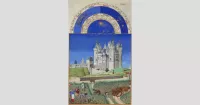Earth, the third planet from the Sun, is unique in harboring life due to its liquid surface water, primarily contained in its vast global ocean covering 70.8% of its crust. The remaining 29.2% is land, largely humid and vegetated. Tectonic plates shape the Earth's surface, creating mountains, volcanoes, and earthquakes. A liquid outer core generates a magnetosphere, protecting the planet from solar winds and cosmic radiation. Polar ice sheets contain more water than all other freshwater sources combined.
1980: Average Death Toll from Extreme Weather (1980-2000)
From 1980 to 2000, extreme weather events such as tropical cyclones caused an average of 11,800 human deaths per year.
2000: Average Death Toll from Extreme Weather (1980-2000)
From 1980 to 2000, extreme weather events such as tropical cyclones caused an average of 11,800 human deaths per year.
2000: Earth's Magnetic Field Characteristics in 2000
In 2000, the magnetic-field strength at the equator of Earth's magnetic field was 3.05×10 T, with a magnetic dipole moment of 7.79×10 Am. It was observed to be decreasing nearly 6% per century.
2006: Observation of Near-Earth Asteroid 2006 RH120
In 2006, it was observed that the near-Earth asteroid 2006 RH120 makes close approaches to the Earth–Moon system roughly every twenty years, orbiting Earth for brief periods during these approaches.
2010: Discovery of Trojan Asteroid Companion 2010 TK7
In 2010, the trojan asteroid companion, 2010 TK7, was discovered librating around the leading Lagrange triangular point, L4, in Earth's orbit around the Sun.
2015: Irrigation of Croplands in 2015
In 2015, 2 percentage points of the 12–14% of ice-free land used for croplands were irrigated.
2018: Planetary Boundaries Assessment in 2018
As of 2018, according to the concept of planetary boundaries, no country meets the basic needs of its population without transgressing planetary boundaries.
2019: Earth Land Use in 2019
In 2019, Earth's land surface consisted of 39 million km of forest and woodlands, 12 million km of shrub and grassland, 40 million km used for animal feed and grazing, and 11 million km cultivated as croplands.
2020: Global Temperatures in 2020
In 2020, global temperatures were estimated to be 1.2 °C warmer than the preindustrial baseline. This temperature increase, or global warming, has contributed to several environmental issues.
September 2021: Earth Satellites in September 2021
As of September 2021, there were 4,550 operational, human-made satellites orbiting Earth, in addition to inoperative satellites and over 16,000 pieces of tracked space debris. The International Space Station (ISS) was Earth's largest artificial satellite.
Mentioned in this timeline
Climate change encompasses global warming and its far-reaching effects on...

Asteroids are minor planets orbiting the inner Solar System or...

September is the ninth month of the year in the...
Trending

3 months ago Mike Vrabel on Patriots' Defense and Primetime Matchup Against Bills

2 months ago Breece Hall suffers injury during game, trade rumors emerge, fantasy football impact.

3 months ago Taysom Hill Nears 2025 Return After Injury: Giants vs. Saints Week 5

8 months ago Chris Olave Trade Rumors Surface Amidst Derek Carr's Retirement and Eagles Interest

2 months ago Michael Vick vs. DeSean Jackson: Norfolk State faces Delaware State in Week 10

8 months ago Bank of America: Shareholders Approve Executive Pay, Elect Directors, and Equity Plan Changes
Popular

Stranger Things created by the Duffer Brothers is a popular...

XXXTentacion born Jahseh Dwayne Ricardo Onfroy was a controversial yet...
The Kennedy Center Honors are annual awards recognizing individuals and...
Turning Point USA TPUSA is an American nonprofit organization founded...

Candace Owens is an American conservative political commentator and author...

William Franklin Graham III commonly known as Franklin Graham is...
